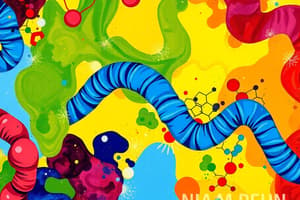Podcast
Questions and Answers
Which functional group in amino acids is responsible for the acidity of the amino acid?
Which functional group in amino acids is responsible for the acidity of the amino acid?
- α-amino group
- Hydrocarbon radical
- Carboxyl group (correct)
- Side chains
What is the characteristic of the α-amino group in amino acids?
What is the characteristic of the α-amino group in amino acids?
- Responsible for the hydrophobicity of amino acids
- Bonded to the carboxyl group in amino acids (correct)
- Has a strong dipole moment
- Contributes to the acidity of amino acids
Which aspect of side chains contributes to the unique properties and functions of proteins?
Which aspect of side chains contributes to the unique properties and functions of proteins?
- Hydrophobic nature (correct)
- Participation in basic reactions
- Neutral charge
- Polar structure
In the carboxyl group, what creates a strong dipole moment?
In the carboxyl group, what creates a strong dipole moment?
What role do side chains play in protein 3-D structure?
What role do side chains play in protein 3-D structure?
What type of bond connects the carboxyl group of one amino acid to the amino group of the next in a protein chain?
What type of bond connects the carboxyl group of one amino acid to the amino group of the next in a protein chain?
Why are the side chains of amino acids important?
Why are the side chains of amino acids important?
Which characteristic of amino acids allows them to interact with both water molecules and avoid contact with them?
Which characteristic of amino acids allows them to interact with both water molecules and avoid contact with them?
What stabilizes the structure of a protein by forming bonds between the amide hydrogen and the carbonyl oxygen of the peptide bond?
What stabilizes the structure of a protein by forming bonds between the amide hydrogen and the carbonyl oxygen of the peptide bond?
Which feature of amino acids is responsible for many of their unique properties within proteins?
Which feature of amino acids is responsible for many of their unique properties within proteins?
Flashcards are hidden until you start studying
Study Notes
Amino acids are organic compounds consisting of amine (-NH2), carboxyl (-COOH) and hydrocarbon radicals, called side chains. They play a crucial role in our bodies' functioning, serving as building blocks for proteins. Let's delve deeper into their structure and properties.
Carboxyl Group
The carboxyl group is a functional group composed of carbon, oxygen, and two hydrogen atoms. It forms part of amino acids and is also found in other organic compounds. The carboxyl group is characterized by a strong dipole moment due to the polar covalent bond between oxygen and carbon and the electron-withdrawing effect of the oxygen atom. In amino acids, the carboxyl group is attached to the alpha carbon atom and is responsible for the acidity of the amino acid.
α-Amino Group
The α-amino group is a functional group that consists of a nitrogen atom (N) bonded to a hydrogen atom (H) and a carbon atom (C). It is the amino group that is attached to the carbon atom bonded to the carboxyl group in an amino acid. The α-amino group is responsible for the basicity of the amino acid when it gains an extra proton (H+) by losing an electron (e-) to become a cation.
Side Chains
The side chains of amino acids vary in structure and size, contributing to the unique properties and functions of proteins. Side chains can be polar or nonpolar, hydrophilic or hydrophobic, charged or neutral, and can participate in various chemical reactions and interactions within proteins. The differences in side chains are what give amino acids their unique chemical properties and allow them to form complex structures like proteins.
Protein 3-D Structure
Proteins are long chains of amino acids connected by peptide bonds, with the carboxyl group of one amino acid bonding to the amino group of the next. The sequence of amino acids determines the protein's 3-D structure, which is essential for its function. Hydrogen bonds between the amide hydrogen and the carbonyl oxygen of the peptide bond stabilize the protein's structure.
Characteristics
Amino acids have several key characteristics that make them versatile building blocks for proteins:
- They are chiral, meaning they have a distinct 3-D shape that influences their interactions with other molecules.
- They can form peptide bonds with each other through condensation reactions, linking amino acids together in specific sequences.
- They have both polar and nonpolar regions, allowing them to interact with water molecules or avoid contact with them, which is crucial for protein stability and function.
- Their side chains can participate in various chemical reactions within proteins and are responsible for many of their unique properties.
In conclusion, understanding the structure of amino acids is crucial for understanding their roles within proteins and their contributions to various biological processes.
Studying That Suits You
Use AI to generate personalized quizzes and flashcards to suit your learning preferences.




